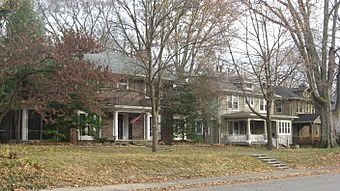Oliver Johnson's Woods Historic District facts for kids
Quick facts for kids |
|
|
Oliver Johnson's Woods Historic District
|
|

Park Avenue in the neighborhood
|
|
| Location | Roughly bounded by Central and College Aves., 44th and 46th Sts., Indianapolis, Indiana |
|---|---|
| Area | 40 acres (16 ha) |
| Architect | William F. Nelson, Fermor Spencer Cannon, et al. |
| Architectural style | Colonial Revival, Renaissance, et al. |
| NRHP reference No. | 04000632 |
| Added to NRHP | June 22, 2004 |
Oliver Johnson's Woods is a special neighborhood in Indianapolis, Indiana. It is also a historic district, which means it has important old buildings and a rich past. This area was once a large farm owned by a pioneer named Oliver Johnson.
Contents
From Farm to a New Neighborhood
Oliver Johnson grew up near the state capital city. In 1846, he bought land a short distance away. He built a larger farmhouse there in 1862. Oliver worked his farm for most of his life.
How the Neighborhood Grew
As Indianapolis started to grow north, it reached the Johnson farm in the early 1900s. Oliver and his sons saw a chance to sell their land. In 1905, they decided to divide about 0.25 square miles (0.65 km2) of their property into many individual lots. This was a good time to sell!
New residents began to build their homes. An interurban railway was also built along College Avenue. This railway connected downtown with Broad Ripple. Many successful business people liked the large lots and tree-lined streets in this new area.
A Diverse Community Forms
The city officially made Oliver Johnson's Woods part of Indianapolis in 1912. By the start of World War II, the streets were full of big houses. These homes were built in many different architectural styles.
Early residents came from many backgrounds. European immigrants were becoming more successful. They were moving out of their original neighborhoods. New places like Oliver Johnson's Woods were very appealing to them. A group of Jewish families of German descent also became important residents in the neighborhood.
Homes and Architecture
The houses in Oliver Johnson's Woods show popular styles from the early 1900s. You can see homes built in the Colonial Revival, Tudor Revival, Arts and Crafts, American Foursquare, and Prairie School styles.
Famous Builders and Unique Homes
Many Colonial Revival houses were built by William F. Nelson. He was both the architect (who designed the homes) and the general contractor (who managed the building).
The most unique house in the district is the original Johnson farmhouse. It is now called the Johnson-Denny House. It used to face Central Avenue. But in 1919, its new owner moved it to face Park Avenue. This happened while the land around it was being developed. Other buildings were once near the house, but they are no longer there.
A Special Place in History
Today, Oliver Johnson's Woods is surrounded by the Meridian-Kessler neighborhood. It is still a beautiful, tree-filled neighborhood for middle-class families, just as it was planned to be.
Becoming a Historic District
In 1979, the Johnson-Denny House was added to the National Register of Historic Places. It was important because of its role in local history. It also had well-preserved historic architecture.
Twenty-five years later, all of Oliver Johnson's Woods became a historic district. It was added to the National Register because of its architecture and local history. The historic area covers about 40 acres (16 ha). Ninety-two buildings within this area were considered "contributing properties." This means they add to the historical importance of the district.
Most of these buildings, ninety of them, are houses. In 1999, a survey by Indiana Landmarks looked at these homes. Four houses were ranked "outstanding." Seventeen were called "notable." The other sixty-nine were simply "contributing."




